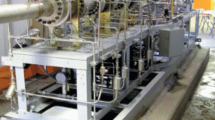Abstract—
The article presents the results from numerically modeling the process circuit of a combined binary-cycle double-flash geothermal power plant (GeoPPs) with the use of secondary flash steam superheating by means of a hydrogen–oxygen steam generator. Geothermal heat carrier from substandard wells of the Mutnovsk geothermal field, as well as separated steam and waste brine from the Mutnovsk GeoPP, were taken as the primary heat source. Numerical investigation results have shown that the application of secondary flash steam superheating by means of a hydrogen–oxygen steam generator makes it possible to increase the steam turbine’s power output and its flow path efficiency owing to the steam wetness reduced by more than a factor of two. In addition, reduced steam wetness helps prevent erosion damage to the last-stage turbine rotor blades. Data on the effect that the use of different organic substances has on the efficiency and power output of the binary installation and of the GeoPP as a whole are given. Optimization investigations have shown that the highest power output and efficiency values of the binary installation used as part of a combined binary-cycle GeoPP at the lowest specific brine flowrate are achieved in using organic substances from the groups of nontoxic fire- and flame-proof (R-31-10 and RC-318) and low-toxic fire- and flame-proof ones (R-227ea, R-236fa, R1318, and R-134a) as working fluids. It has been established that the highest power output values of a combined binary-cycle double-flash GeoPP with secondary flash steam superheating by means of a hydrogen–oxygen steam generator are achieved in using the organic working fluids R-31-10, R‑227ea, and RC-318. In so doing, the optimum design pressure in the expander-separator at which the highest efficiency and power output of the studied GeoPP are obtained makes 0.47 MPa. In solving optimization problems on selecting the working fluids for binary combined-cycle GeoPP installations, it is proposed to use multiaxial composite diagrams of the relative values of geothermal power plant parameters and characteristics. An example of drawing a multiaxial composite diagram for the relative values of parameters and characteristics for a combined binary-cycle GeoPP for the R-290, R-31-10, R-32, and RC-318 working fluids is given. The numerical investigation results can be used in designing new and modernizing the operating GeoPPs that use steam geothermal sources.










Similar content being viewed by others
REFERENCES
R. A. Meyers, Encyclopedia of Physical Science and Technology (Elsevier, San Diego, CA, 2001).
E. Macchi and M. Astolfi, Organic Rankine Cycle (ORC) Power Systems: Technologies and Applications (Woodhead, Cambridge, 2017).
Y. Kato, M. Koyama, Y. Fukushima, and T. Nakagaki, Energy Technology Roadmaps of Japan: Future Energy Systems Based on Feasible Technologies Beyond 2030 (Springer-Verlag, Tokyo, 2016).
G. V. Tomarov, A. A. Shipkov, A. I. Nikol’skii, and V. N. Semenov, “Combined cycle power unit with a binary system based on waste geothermal brine at Mutnovsk geothermal power plant,” Therm. Eng. 63, 409–413 (2016). https://doi.org/10.1134/S0040601515120113
R. DiPippo, Geothermal Power Plants: Principles, Applications, Case Studies and Environmental Impact (Butterworth–Heinemann, Oxford, 2015). https://doi.org/10.1016/B978-0-08-100879-9.00009-4
G. V. Tomarov, V. I. Borzenko, and A. A. Shipkov, “Optimization investigations of a combined binary-cycle geothermal power plant with two separation pressures and flashed steam superheating using a hydrogen-oxygen steam generator,” Therm. Eng. 66 (10), 760–768 (2019). https://doi 10.1134/S0040363619100060
V. I. Borzenko and A. I. Schastlivtsev, “Efficiency of steam generation in a hydrogen-oxygen steam generator of kilowatt-power class,” High Temp. 56, 927–932 (2018). https://doi.org/10.1134/S0018151X1806007X
D. O. Dunikov, “Cycle improvement and hydrogen steam superheating at Mutnovsky geothermal power plant,” Case Stud. Therm. Eng. 12, 736–741 (2018). https://doi.org/10.1016/j.csite.2018.09.010
Funding
This work was supported by the Russian Federation Ministry for Education and Science within the framework of the Federal Target Program “Investigations and Developments in the Priority Development Lines of the Scientific-Technological Complex of Russia for 2014–2020” (subsidy granting agreement no. 14.607.21.0188, unique identifier of applied scientific investigations RFMEFI60717X0188).
Author information
Authors and Affiliations
Corresponding author
Additional information
Translated by V. Filatov
Rights and permissions
About this article
Cite this article
Tomarov, G.V., Shipkov, A.A. A Combined Binary-Cycle Geothermal Power Plant with a Secondary Flash Steam Superheating System: Choice of Optimal Working Fluids. Therm. Eng. 66, 822–829 (2019). https://doi.org/10.1134/S0040601519110065
Received:
Revised:
Accepted:
Published:
Issue Date:
DOI: https://doi.org/10.1134/S0040601519110065




